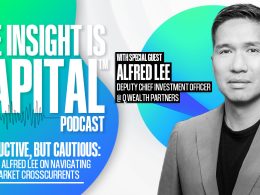by Neuberger Berman
Amid slower economic growth and more benign monetary policy, we believe that this year bond prices will be driven less by inflation and central bank policy and more by economic growth dynamics. Rather than seek to play the timing of interest rate reductions, we think it will be more effective to focus on the ultimate destination of rates and adapt portfolios accordingly. We favor putting cash to work in short-duration fixed income, while emphasizing quality credits and, selectively, pockets of value in global markets.
Commentary
With monetary tightening largely over, central bank actions could take a back seat to growth trends in pricing fixed income assets.
For much of 2023, the focus of bond markets was on stubborn inflation trends tied to a resilient economy and the resulting hawkishness of central banks. A few early bank failures prompted a temporary scare over the impacts of monetary tightening, but risk assets stabilized as an overhang of COVID-19 stimulus and worker shortages helped keep labor markets tight and consumers in a spending mood. The arrival of weak Treasury auctions in the fall prompted new worries about debt oversupply amid government overspending, sending bond prices downward and the 10-year U.S. Treasury yield to over 5%.
Starting in mid-October, however, global market rates reversed course as inflation prints surprised on the downside and economies decelerated. Germany is now probably in a recession; Europe overall could also turn negative shortly; and after a blowout third quarter, the U.S. economy seems likely to settle into moderately positive territory, achieving a “soft landing.”
Importantly, central banks appear to be largely done raising interest rates, with the Federal Reserve likely to move into rate cuts this year—whether three reductions as reflected in FOMC projections or closer to the market’s expectation of five. Europe may take longer, but has also shifted toward anticipation of easing. Overall, we believe monetary policy in itself is likely to be less of a driver for bond markets as inflation becomes more predictable. Rather, the focus could shift more to economic growth. Rather than seek to play shifts in investor sentiment as rates decline, we think it’s more important to focus on the ultimate destination for interest rates and adapt portfolios accordingly.
Adapting to the New EnvironmentIn the coming year, we expect yields to maintain a downward bias as the lagging effects of tight monetary policy take hold and central banks initiate interest rate cuts. Our expectation for the terminal fed funds rate is around 3%, with inflation ultimately around the 2% target—likely achieved by sometime in 2025. Although we see fair value for the 10-year U.S. Treasury at around 4.25%, we are cognizant that various premia on long-term bonds are hard to price given widespread fiscal profligacy and geopolitical tensions.
With the rapid decline in rates, we favor monetizing recent gains on duration while maintaining some exposure to capture the benefits of further easing. At the same time, we believe it’s important for those with large cash exposures to move some of those assets to shorter maturities to avoid losing out on yield when the Fed actually initiates cuts. In credit, spreads have remained narrow, powered by stable results and low defaults, even in strongly performing lower-quality segments. However, we are now seeing a bifurcation in the market favoring quality even as any overall spread-widening due to the weakening economy is likely to be mild. Areas of emerging markets, which experienced severe pressure during the tightening campaign, should continue seeing favorable results.
Overall, we believe that 2024 could be a rewarding time for global bond investors, assuming one treads carefully given the recent aggressive downward shift in rates and focuses on fundamentals and selectivity in building portfolios.
Our investment themes for 2024 appear below.
1. Growth Takes Center Stage
With inflation trends improving and central banks’ interest rates likely at their peak, we believe that economic growth outcomes will rise in importance for driving fixed income returns. Europe is already close to a recession, while China continues to struggle with structural growth pressures and global trade levels decline (see display). The U.S. is in better shape, but is showing signs of a slowdown, including the loss of manufacturing jobs, rising consumer delinquencies and an increase in continuing unemployment claims. Despite resilient recent reports, job creation may be the next shoe to drop, with the potential for near-term prints of below 100,000 followed by sub-50,000 sometime this year when lodging and leisure employment is likely to slow. Overall, the influence of services employment (see display) makes the U.S. less vulnerable to—but not immune from—a slowdown.
At the same time, we believe inflation should ease more this year in the U.S. and Europe, and in contrast to the last two years, become more predictable. If anything, inflation tail risks skew to the downside at this point, consistent with recent releases and ongoing stagnation of goods prices.
Weak Trade Is a Headache for Globally Oriented Markets
Source: Bloomberg, as of September 2023.
Mounting Pressure on Services-Heavy U.S. Economy
Source: BEA as of October 2023, BLS, as of November 2023.
2. Central Banks: Not the Path, but the Destination
Investors have been preoccupied with the path of interest rates, but with the likely end to monetary hikes, we believe that near-term ups and downs should be less important than the end point on policy.
In our view, the Federal Reserve may have become overly restrictive—which shouldn’t be surprising given its reliance on “current” rather than forward data. Our analysis suggests that the fed funds rate could eventually settle at around 3% (assuming 2.5% inflation and a 1% real yield) or 2.25% lower than current policy rates. This suggests that two-year and five-year Treasury rates could drop over 100 basis points from here.
However, this doesn’t mean that investors should try to time this easing, which could emerge quickly or take some time. In our view, investors in cash deposits should move quickly to hold up to five-year-maturity fixed income, which allows for locking up still-elevated rates before they fade away.
Amid more rapid slowing in the eurozone, the European Central Bank is beginning to worry that it will miss its inflation targets to the downside. Our estimate for long-term equilibrium short-term rates in the eurozone is 200 basis points lower than current overnight rates.
Markets Expect Rapid Easing, but Delay Poses Little Risk to Shorter Bonds
Source: Bloomberg, Neuberger Berman calculations, as of December 7, 2023. In the downside scenario, Fed/ECB policy rates are modeled as unchanged at current policy levels throughout 2024, followed by modeling a faster easing cycle in 2025 that prices policy rates to 3% and 2% for the Fed and ECB, respectively.
3. Long Rates:
Uncertainty Over ‘Fair Value’Ever since the global financial crisis, investors have largely been able to ignore various issues that affected the perceived fair value of long-term rates. That seems to have changed: The sunset of quantitative easing, rising inflation volatility, the end of zero or negative rates and increasing debate around the sustainability of government budgets mean that long-term rates are likely to reflect a premium for uncertainties tied to a multiyear obligation. This past fall, the U.S. bond market was spooked by large, poorly received Treasury auctions, contributing to a melt-up in long-term yields. Although investors were later appeased by adjustments to auction volumes and softening economic fundamentals, the term-premium issue remains beneath the surface as countries grapple with ballooning deficits and seemingly little appetite to rein in spending. Complicating the situation is the withdrawal of many sovereign buyers, leaving demand more in the hands of price-sensitive private investors. Overall, the pricing of longer-term equilibrium rates could become more complicated and dynamic. At this stage, we think the long-term fair value for U.S. 10-year Treasuries is around 4.25%—not too far from where it was prior to the Fed’s December meeting. In our view, it’s prudent to expect overshoots (and undershoots) in the coming quarters and years as the market shifts to more normal levels of volatility with reduced influence by policy-driven buyers.
Current 10-Year Rates Are Close to Our Fair Value Estimates
Source: Bloomberg, Neuberger Berman, as of December 7, 2023. Assumes normalized inflation expectations and trend-like growth.
The Term Premium Could Move Back to Normal

4. Corporate Credit:
Tight Spreads but Continued OpportunityWith credit spreads at the tighter end of their range, it may seem that investors can do little to enhance returns in the corporate universe. However, we believe divergences that began to emerge in 2023 could create opportunities in 2024.
Within investment grade, inverted or flat yield curves suggest that a two- to three-year range for corporates is relatively cheap, especially given outperformance of longer bonds due to reduced issuance, and could benefit from flows out of cash this year. We like shorter-term financials and in general favor moving “up in quality” while keeping exposure in defensive sectors such as telecom, utilities and certain pharmaceuticals. Agency mortgage-backed securities also show opportunity, with discounted underlying assets and spreads above their 20-year average; AMBS have tended to outperform corporate counterparts after periods of tightening.
We could see a modest credit-spread reset in the event of gradually weakening fundamental indicators. However, if it’s clear a soft landing is going to occur, there could be a material rally in spreads—particularly in the lower-quality segments of the credit markets, including high yield and loans. Meanwhile, supply remains a wild card. Last year, a lack of M&A and refinancings limited the issuance calendar. A looser environment could prompt more companies to make deals—perhaps in the second half of the year, leading to more issuance and a technical headwind for prices.
In non-investment grade, we anticipate a higher default rate that nonetheless remains close to historical norms. Managements are generally well prepared for the coming slowdown, and have been able to extend near-term maturities. Still, as the economy slows, we could see an increasingly bifurcated market, favoring BB and BB+ issues over CCCs, which, after a period of outperformance, are potentially likely to lag more conservative counterparts.
Finally, a relative value lens points to inexpensive European credit markets, across the investment grade, hybrids and non-investment grade markets. In contrast to the U.S., European credit faces significant maturities this year, exacerbated in part by delayed issuance from companies seeking to benefit from lower rates. While we are confident that most will secure the financing they need, economic weakness is generally creating more operating pressure and we are starting to see greater differences between higher and lower quality—a trend that could last until the economy starts to rebound.
Shorter-Term Investment Grade Corporates Currently Provide Better Value
Source: Barclays Bloomberg, Morgan Stanley.
Growing Credit Dispersion in Non-Investment Grade

5. Emerging Markets:
Easier Conditions Spell OpportunityWe believe that recent strength in emerging markets debt should continue as various trends that dampened performance after the COVID-19 pandemic continue to recede, including emerging markets’ relative lack of supportive fiscal measures, significant inflationary pressure, sometimes unorthodox monetary policy and China’s extended slowdown. Once-negative technical factors have shifted in a positive direction: Flows have started to improve, and issuance has been subdued, especially among corporates.
Refinancing risks remain elevated for a number of high-yielding, distressed sovereigns with little access to external capital markets, but we believe the peak of the default cycle has long passed. Multilateral engagement will remain key to support external funding needs, and more importantly, to drive structural reforms to get these sovereigns back on track. Certain names may find themselves unable to service their debt or may choose to default preemptively, but their stories are fairly well known and non-systemic, and therefore unlikely to prove broadly disruptive.
China remains a wild card. Key indicators including PMIs continue to moderate, while GDP growth remains anemic, even as the government’s stimulus appears inadequate. Without material improvement in China’s economy, emerging market growth could remain disappointing.
That said, relative stability could be a positive for emerging markets debt, whose performance has much ground to recover despite a favorable 2023 for some segments. In our view, local markets will likely continue to show strength, along with hard currency bonds, as developed-market interest rates fall and investors seek higher yields.
An End to Developed-Market Tightening Should Favor Emerging Markets Debt
Source: Bloomberg, JPMorgan. EMD hard currency represented by the JPMorgan EMBI Global Diversified Index; EMD local currency represented by the JPM GBI-EM Global Diversified Index.
Market Views
Next 12 Months
Views expressed herein are generally those of the Neuberger Berman Fixed Income Investment Strategy Committee and do not reflect the views of the firm as a whole. Neuberger Berman advisors and portfolio managers may make recommendations or take positions contrary to the views expressed. Nothing herein constitutes a prediction or projection of future events or future market behavior. Due to a variety of factors, actual events or market behavior may differ significantly from any views expressed. See additional disclosures at the end of this material, which are an important part of this presentation.*Currency views are based on spot rates, including carry.
Copyright © Neuberger Berman



























